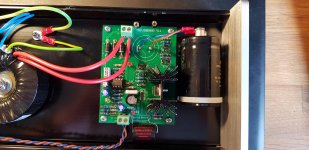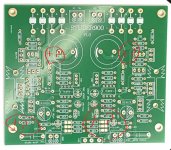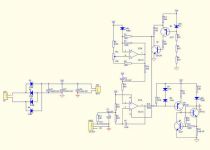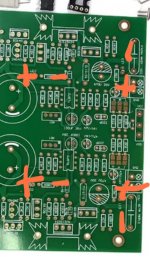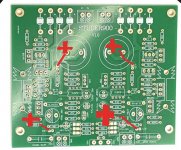My single supply board says 15R but a 7.5R resistor was supplied. Thre seller's explanation was higher current handling.On my board both are 15R. I also have a single supply board which doesn't appear to use this resistor at all.
I need to correct an earlier statement, when I said that the Kemet ALS30 smoothing cap was not as detailed as the Panasonic FR pair. It turns out that how a big can is mounted makes a big difference in the sound. I had the Kemet on its side secured with a zip tie around each end. When I removed the zip tie at the top and used only the zip tie at bottom, the detail and HF was more balanced. However, having the zip tie at the very bottom edge of the cap’s case gave too much HF detail and too little LF as in the attached photo. So I found it best about 1cm up from the bottom....noticed that the high notes (piano, cymbals, etc.) are a touch dull.Their tone is dull, lacking the musical sparkle of my other power supplies. @200+ hours...
- Smoothing cap: Panasonic FR 2 x 5600uF. Also tried a Kemet ALS30 6800uF, which had slightly better bass but slightly worse HF detail.
Also, the HF tone corrected itself with a few more hours and in repositioning the speakers per the manufacturer’s recommendations.
Attachments
Will do, after I spend a bit of time with this sound. Also I want to see if a higher quality wirewound resistor will have any effect ...eventually.Interesting.!
Why not try the film caps over the rectifier diodes...quite an easy one to do.
By FAR the most common failure mode is a short which shows up as 0 ohms from emitter to collector.
A simple ohm meter will show that. The reason for the failure is too much heat or simply exceeding the
maximum current or Voltage limits. Unless you shorted the supply output potentially exceeding the
current limit, it's likely just too hot. Bigger heat sink and/or more air circulation would fix it.
G²
A simple ohm meter will show that. The reason for the failure is too much heat or simply exceeding the
maximum current or Voltage limits. Unless you shorted the supply output potentially exceeding the
current limit, it's likely just too hot. Bigger heat sink and/or more air circulation would fix it.
G²
I use one to power a dac output stage +/- to the opamps.
If one rail went bad would it mean that because the opamps maybe would then only get a single rail that damaging DC could be output?
If one rail went bad would it mean that because the opamps maybe would then only get a single rail that damaging DC could be output?
how would you rate original Nover smoothing cap - Is It reason for dull sound
how about Mundorf M lytic AG as smoothing cap
how about Mundorf M lytic AG as smoothing cap
I'm using this at 5v to drive my DAC, with a few capacitor changes. The detail is good with a good soundstage, but but noticed that the high notes (piano, cymbals, etc.) are a touch dull.Their tone is dull, lacking the musical sparkle of my other power supplies. @200+ hours. Any thoughts on what I might consider swapping out?
Substitutions @buildup
- Smoothing cap: Panasonic FR 2 x 5600uF. Also tried a Kemet ALS30 6800uF, which had slightly better bass but slightly worse HF detail.
- Wima Poly cap for Mundorf Supreme EVO.
- Striped 221 220pF for Kemet 221 220pF MLCC
Last edited:
I didn't listen to the Nover, but it was a likely place to seek better. I could find no specs on it. I figured if changing to something else, go for low ESR and high ripple... Mundorf Mlytics seem respected in audio circles and I have them in my amp, but I don't recall them ever quoting ESR.how would you rate original Nover smoothing cap - Is It reason for dull sound
how about Mundorf M lytic AG as smoothing cap
same result here
I did change LA Nover 6800 / 35 with Nichicon KG 4700 / 63 In dac linear power supply
Nover brand Is kind of mysterious
I did change LA Nover 6800 / 35 with Nichicon KG 4700 / 63 In dac linear power supply
Nover brand Is kind of mysterious
I put Nichicon Gold Tune 4700uf in place of thr Nover. Not sure I could hear a difference.
Hi Guy's. No response from Minisnow (E/bay seller) for several days. So will have to try to repair the unit myself.
Which for me with very limited knowledge will be very difficult. Fortunately these units will also work off of DC so I should not zap myself with 240 V.
So I need to know what is the MJE15034 is, is it a NPN or PNP type, so I can order a replacement.
Cheers
MJE15034: Bipolar Transistor, NPN, 350 V, 4.0 A
how would you rate original Nover smoothing cap?
how about Mundorf M lytic AG as smoothing cap
Nover Audio Grade caps are oft used in China PSUs and audio kits in mid+ price gear. I'd say they are price-accessible audio grade caps common in China.
I've replaced 10,000uF 80V Elna LA5 caps (not Elna Silmic) in a good power amp (Parasound A52) with Nichicon LS (non audio grade) and Mundorf MLytic (audio grade) caps.
Clearly the Mundorfs are way superior in A/B comparison (after much burn in) against a stock Parasound amp - more real, more elegant SQ etc.
Newer Parasound Halo amps like the HINT (integrated) have switched to Lelon instead the Elna (non audio grade), probably because of price.
Their higher amps use Rubycon and their highest level amps (JC1, JC1+, JC5) use Nichicon KG Gold Tune Type I which are slightly less expensive than the Mundorfs and slightly below in SQ.
I've also used Jensen 4-pole caps, which require a basic change to the circuit to separate the input side common from the output side common to maximize the inductance effect of the 4-pole and allow it to behave like a CLC filter. But these are bloody expensive and amazing.
So overall, seems SQ is somewhat related to price in above experience, with Nover, Rubycon and Nichicon KG offering better price/performance than more exotic brands like Mundorf and Jensen.
The other consideration is whether there's a regulator between the filter caps and the consuming audio stage. In the case of a power amp output stage, which normally would not use regulator - the quality of the filter cap seems to have a more direct impact on the SQ. If the audio stage is a preamp or DAC, the results may be more governed by the regulator and regulator output cap than the rectifier filter cap.
For a pass/fail test, a simple tester like this should work.Hi, Well I have had my 24 VDC fully build up Studer 900 for 10 months now driving my Clearaudio Fanfare Phono amp & it has unfortunately blown up. I believe that the MJE15034G Transistor has blown, at least that is where the burnt smell comes most from. I bought it from minishow on E/Bay & it is supposedly covered by a 1 year warranty. have contacted the seller & it will be interesting to see what he says.
However in case he reneges, how do I test the MJE15034G Transistor.
Cheers
LCR-TC1 Pocket Multifunction Transistor Tester Full Color Graphics Display US | eBay
I am very happy with the multi-function tester. Perfect for transistor and diode quick check.Hi keilau, Thanks for the link to the tester, have ordered one.
Cheers
It comes with 3 tiny hook clip grabber which are very flimsy and difficult to use in tight space. It gets even worse when testing components on board. Get some bigger ones at Amazon.
5 Pairs Multimeter Part Colorful Hook Clip Grabber Test Probe for Electronic Testing: Amazon.com: Industrial & Scientific
You can find a complete user's manual here.
https://www.circuitspecialists.com/content/430516/csi-tc1.pdf
Can someone please detail the led pin orientation (for each led) on the dual supply board....thanks !
(the silkscreen is of no help as it is not logical side to side 🙁 )
(the silkscreen is of no help as it is not logical side to side 🙁 )
- Home
- Amplifiers
- Power Supplies
- low noise Pre-Amp / DAC power supply MJE15034 TL072 Regulator based on STUDER 900
